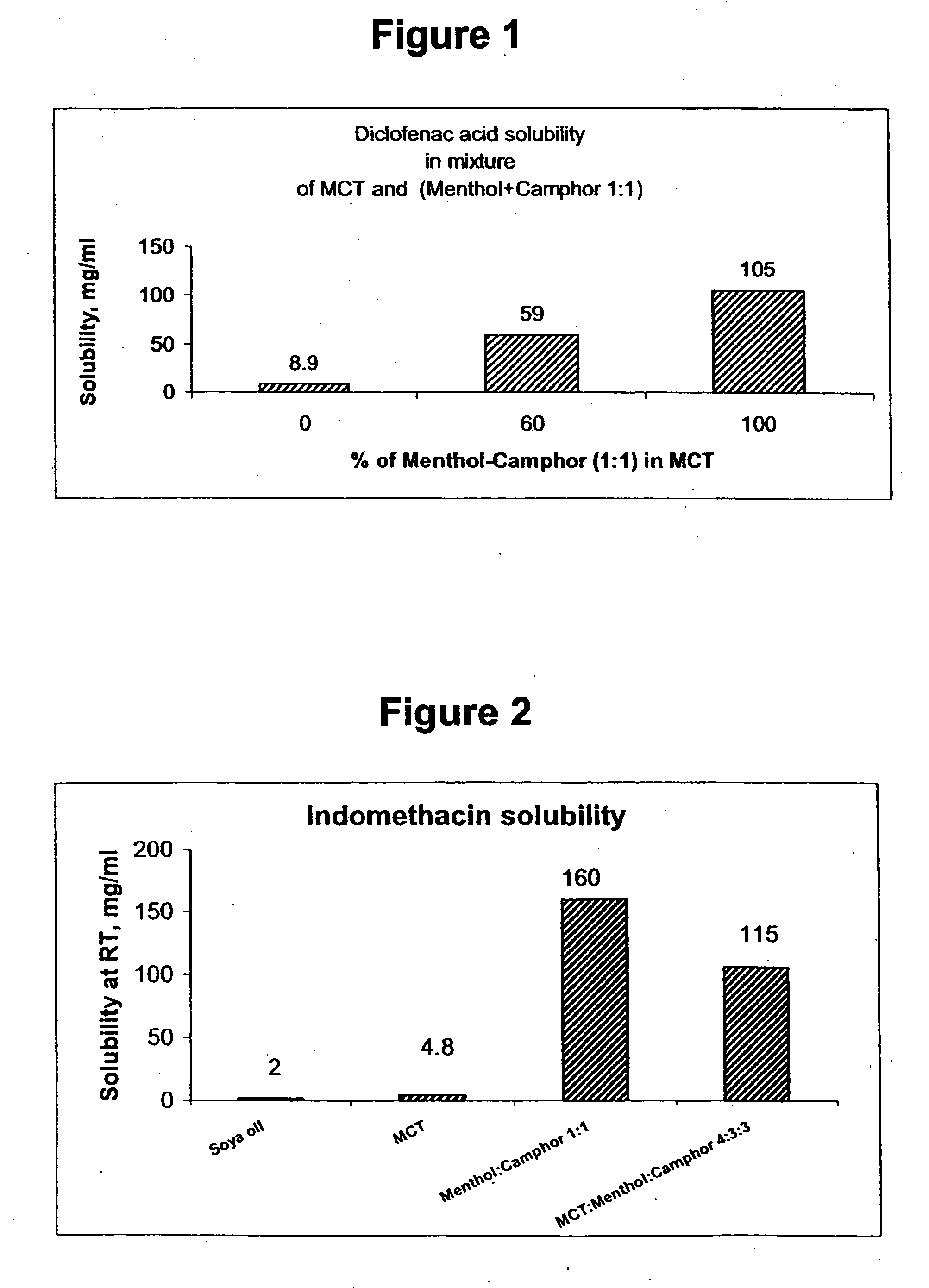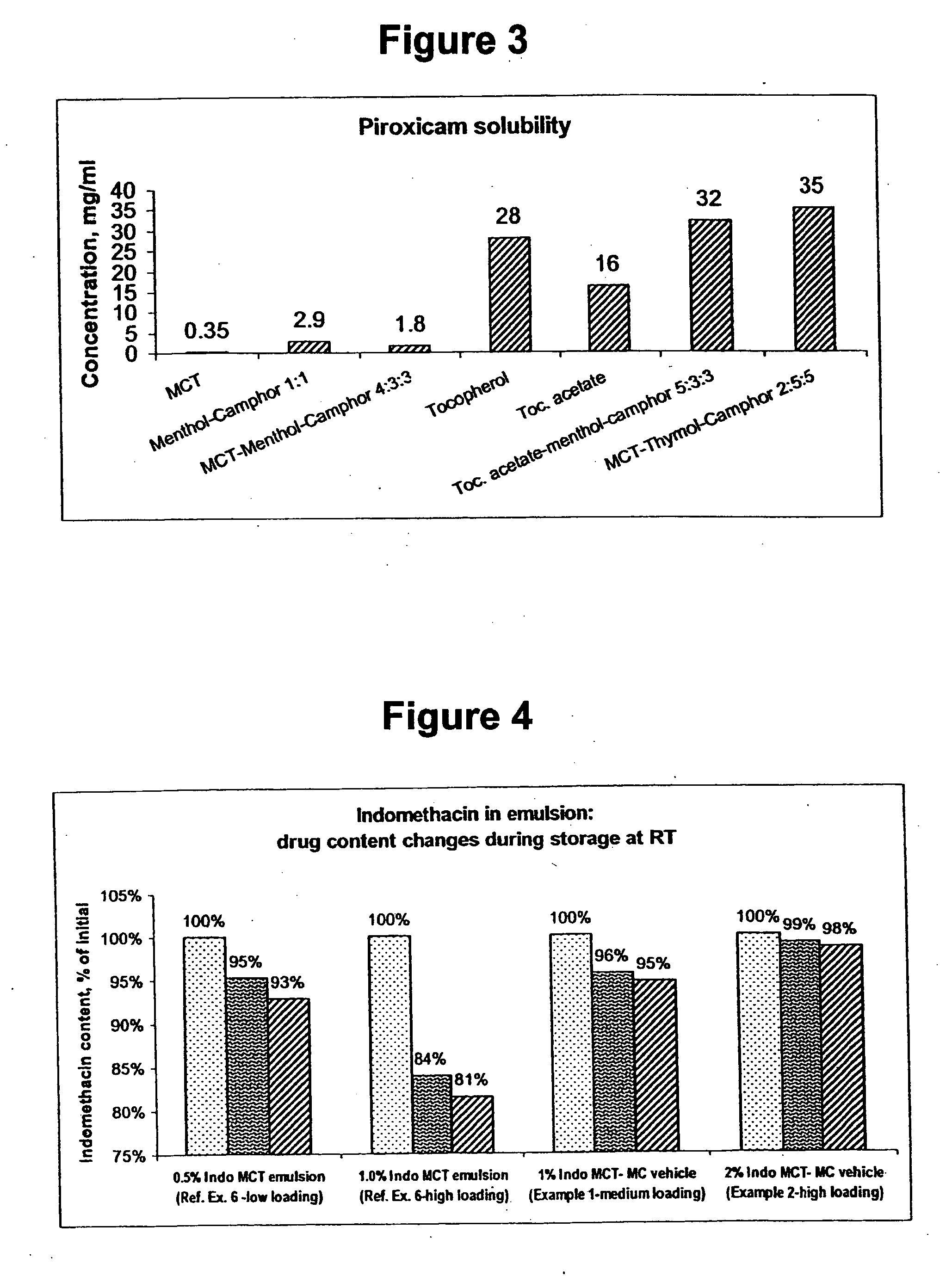Vehicle for topical delivery of anti-inflammatory compounds
a technology of anti-inflammatory compounds and liquids, which is applied in the field of preparation of semisolid formulations, can solve the problems of low drug loading, frequent limited widespread use, and serious irritation of stomach and gastro-intestinal mucosa, and achieve synergistic behavior of anti-inflammatory action and solubility of indomethacin
- Summary
- Abstract
- Description
- Claims
- Application Information
AI Technical Summary
Benefits of technology
Problems solved by technology
Method used
Image
Examples
example 1
Indomethacin 1% Cream
[0042]
Per 250 gCREAM INGREDIENTS%creamIndomethacin USP1.002.5Medium Chain Triglycerides (Labrafac ® CCTG)4.0010Soy Lecithin (Phospholipon ® S-80)1.002.5(±) Camphor USP3.007.5L-(−)-Menthol USP3.007.5Tween ™-80 (Polysorbate 80, USP)1.604.0TPGS (Tocopherol polyethylene glycol0.802.01000 succinate)Sodium Ethylenediamine tetraacetate0.100.25(EDTA sodium)Carbopol ® 971P1.503.75Glycerin USP2.506.25Water81.50203.75
Vehicle (Eutectic Mixture) Preparation:
[0043] (±) Camphor and L-Menthol were mixed together during heating at between 40 and 50° C. until a clear liquid was obtained.
Oil Phase Preparation:
[0044] Soy lecithin, MCT oil and TPGS were mixed together at 45° C. until a homogenous solution was obtained. Tween™-80 as then added, followed by the addition of the eutectic mixture vehicle. The mixture was stirred until completely dissolved. Indomethacin (USP grade) was added to the warm mixture and stirred for 10 minutes at 45° C. until completely dissolved.
Water ...
example 2
Indomethacin 2% Cream
[0048] The composition was prepared in accordance with the methodology of Example 1.
Per 100 gPerCREAM INGREDIENTScream1000 gLipid PhaseIndomethacin USP2.0020.00Medium Chain Triglycerides (Labrafac ® CCTG)8.0080.00Egg Lecithin S-752.0020.00(±) Camphor USP6.0060.00L-(−)-Menthol USP6.0060.00Tween ™-80 (Polysorbate-80 USP)2.0020.00TPGS (Tocopherol polyethylene glycol0.808.001000 succinate)Water PhaseSodium Ethylenediamine tetraacetate0.101.00(EDTA sodium)Bronopol ® (2-Brom-2-nitro-1,3-propanediol)0.101.00Triethanolamine0.505.00Ultrez ™ 100.505.00Glycerin2.2022.00Water69.80698.00
[0049] Bronopol® (2-Brom-2-nitro-1,3-propanediol) was added to the water phase as an antibacterial preservative. Ultrez™ was used as a viscosity regulating component instead of Carbopol® without the preliminary hydration step as set forth in Example 1.
example 3
Diclofenac Sodium 1% Cream
[0050] The composition of the emulsion for 1% Diclofenac cream presented in Table 3. The cream contains approximately 14% of the oil phase with a ratio MCT: Camphor: Menthol of 6:3:4.
CREAM INGREDIENTSPer 100 g creamMedium Chain Triglycerides (Labrafac ® CCTG)6.00(±) Camphor USP3.00L-(−)-Menthol USP4.00Tocopherol succinate0.02Soy Lecithin (Phospholipon ® S-80)0.12Tween ™-80 (Polysorbate - 80)2.00Diclofenac Sodium USP1.00Water80.38Hydrochloric acid 1N3.5
[0051] The oil phase was prepared by dissolving MCT, oil Tocopherol succinate, lecithin, camphor, and menthol at 45° C.
[0052] The water phase was prepared by dissolving Diclofenac sodium and Tween™-80 in hot 85° C. purified water.
[0053] After mixing the warm oil and hot water phases, hydrochloric acid was added to coarse emulsion while intensive stirring. The pH was adjusted to between 3.5 and 4.2. Homogenization was conducted as described in Example 2. After a fine emulsion was obtained, it was filtered ...
PUM
| Property | Measurement | Unit |
|---|---|---|
| melting point | aaaaa | aaaaa |
| solubility | aaaaa | aaaaa |
| solubility | aaaaa | aaaaa |
Abstract
Description
Claims
Application Information
 Login to View More
Login to View More - R&D
- Intellectual Property
- Life Sciences
- Materials
- Tech Scout
- Unparalleled Data Quality
- Higher Quality Content
- 60% Fewer Hallucinations
Browse by: Latest US Patents, China's latest patents, Technical Efficacy Thesaurus, Application Domain, Technology Topic, Popular Technical Reports.
© 2025 PatSnap. All rights reserved.Legal|Privacy policy|Modern Slavery Act Transparency Statement|Sitemap|About US| Contact US: help@patsnap.com



